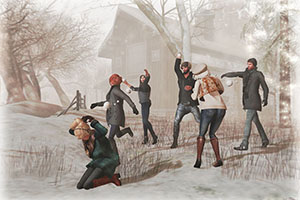Ninth Circuit Says Sims Flash Drive Design May Be Eligible for Copyright
Get Legal Help Today
Find the right lawyer for your legal issue.
Secured with SHA-256 Encryption
Mary Martin
Published Legal Expert
Mary Martin has been a legal writer and editor for over 20 years, responsible for ensuring that content is straightforward, correct, and helpful for the consumer. In addition, she worked on writing monthly newsletter columns for media, lawyers, and consumers. Ms. Martin also has experience with internal staff and HR operations. Mary was employed for almost 30 years by the nationwide legal publi...
Published Legal Expert
UPDATED: Feb 27, 2017
It’s all about you. We want to help you make the right legal decisions.
We strive to help you make confident insurance and legal decisions. Finding trusted and reliable insurance quotes and legal advice should be easy. This doesn’t influence our content. Our opinions are our own.
Editorial Guidelines: We are a free online resource for anyone interested in learning more about legal topics and insurance. Our goal is to be an objective, third-party resource for everything legal and insurance related. We update our site regularly, and all content is reviewed by experts.
UPDATED: Feb 27, 2017
It’s all about you. We want to help you make the right legal decisions.
We strive to help you make confident insurance and legal decisions. Finding trusted and reliable insurance quotes and legal advice should be easy. This doesn’t influence our content. Our opinions are our own.
On This Page

The Sims is a “life simulation” video game from Electronic Arts (EA). Players create virtual people (called “Sims”) and build them virtual homes and communities to live in. They can even buy virtual furniture from the Ikea catalog.

EA holds a copyright for the PlumbBob icon design.
When The Sims 3 was about to be released, EA ordered flash drives shaped like the PlumbBob to be sold with the game. EA worked with a company called Lithomania, and Lithomania hired a company called Direct Technologies (DT) to make a prototype.
Price Cutting
Lithomania then sent the prototype flash drive to a Chinese company that offered to make it for 50 cents less than the Direct Technologies price.
Once the Chinese flash drives came out on the market, DT sued Electronic Arts, claiming that DT was the joint owner of a copyright for the PlumbBob drive and thus that it was entitled to share the profits from the drive.
The district court ruled in favor of Electronic Arts, finding that the flash drive wasn’t “original” enough to qualify for copyright protection, and also that DT had signed a vendor agreement transferring all rights in the drive to EA.
On appeal, the Circuit Court vacated the district court’s decision, finding that DT could win if the case went to a jury “if the contract was fraudulently induced, such that it was invalid from the beginning.”
Derivative Works
Because EA owned the copyright to the original 2-D version of the icon, the issue at the heart of the case was whether DT’s 3-D version of the icon in the form of a flash drive was entitled to copyright protection as a “derivative work.”
A “derivative work” is a work based on something that already exists, and the term usually arises in the context of copyright law.
For example, the stage musical “West Side Story” is a “derivative work,” of “Romeo and Juliet.” The movie version is a derivative work of the stage version. The German version is a derivative work of the English version, etc.
As the court noted,
If DT contributed material “distinguished from the preexisting material employed in the work,” DT can claim a copyright in its contributions.
DT claimed that its design was original because:
- The EA version of the icon had 20 unequal sides, and the flash drive had 12 equal sides.
- The flash drive was designed to fit into the icon-shaped housing with a “futuristic cut away look . . . at a unique angle.”
The court rejected the 12-sides-versus-20-sides argument, but said that
if a jury determines that the manner in which DT designed the USB drive to fit into the PlumbBob object is artistic and non-functional, … we hold that there is a genuine issue of material fact as to whether DT’s USB drive is sufficiently original to warrant copyright protection. That aesthetic feature is “something recognizably the artist’s own,” and a reasonable jury could determine that it meets the “low” standard for originality.
Photo Credit: .snowball fight. by Luna Jubilee / !bang poses. Attribution 2.0 Generic.
Find the right lawyer for your legal issue.
Secured with SHA-256 Encryption
Mary Martin
Published Legal Expert
Mary Martin has been a legal writer and editor for over 20 years, responsible for ensuring that content is straightforward, correct, and helpful for the consumer. In addition, she worked on writing monthly newsletter columns for media, lawyers, and consumers. Ms. Martin also has experience with internal staff and HR operations. Mary was employed for almost 30 years by the nationwide legal publi...
Published Legal Expert
Editorial Guidelines: We are a free online resource for anyone interested in learning more about legal topics and insurance. Our goal is to be an objective, third-party resource for everything legal and insurance related. We update our site regularly, and all content is reviewed by experts.
